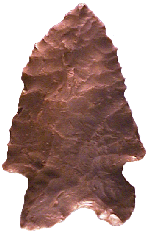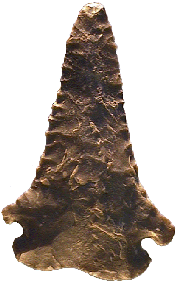



Point Type: MacCORKLE a.k.a.
LARGE BIFURCATE
Also See: Buzzard Roost Creek, Cossatot River, Drake Indented Base,
Jerger, Kirk-Bifurcated, LeCroy, Montell, Rice
Lobbed, St. Albans, Southampton, Susquehanna Bifurcate, Uvalde
Location: Midwestern and Eastern United States
Associated Dates:
9000 - 6000 B.P. - Early Archaic
Morphology: Bifurcated
General Description: The MacCorkle type is a medium to large sized, thin, corner notched point that has a basal indentation or notch which gives it an overall bifurcated stem morphology. The blade is triangular with straight to excurvate edges that are sometimes serrated. The shoulders are angular. The stem is expanding in shape and has diagonal large lobed corners which are always accompanied by a basal notch or indentation. The basal ears are large and rounded which give the type a lobed appearance. The edges of the stem and base a usually heavily ground from shoulder to shoulder, completely encircling the lobes. The bifurcation is typically edge-retouched on one face and bears a large hertzian cone flake scar on the opposite face. In many specimens, the base is the thickest part of the projectile.
The MacCorkle type is an Early Archaic point type. It is often found in West Virginia and is also found in adjoining states and as far east as Massachusetts, as far west as Illinois, as far north as Michigan, and as far south as Alabama. The MacCorkle is known as the "Large Bifurcate" in Ohio. The MacCorkle is often compared to and confused with the Kirk Corner Notched point type from which it may be a descendent. The LeCroy point and the St. Albans chronologically follow the MacCorkle. A variant of the MacCorkle which is found in Missouri is the Rice Lobbed. The Rice lobbed were resharpened by beveling and not serration.
The MacCorkle point can range in size from 40 mm to 84 mm in length, 22 mm to 47 mm wide and 3 mm to 6 mm in thickness. The stem length ranges from 12 mm to 17 mm and the stem width ranges from 18 mm to 36 mm. The type was named and described by Bettye Broyles in 1966 for examples which she recovered from the St. Albans site, Kanawha County, West Virginia.
About The Point Above (Right): The large MacCorkle point pictured at the top right of this page is made from a dark grayish flint or hornstone material. The point has been reworked to such an extent leaving it in a drill form. This specimen should not be regarded as a typical example of the type due to its size and outline. The point measures 79 mm in length, 45 mm wide across the barbs and is 7 mm at its thickest point near the shoulders. The base tapers down to 2 mm in thickness and is heavily ground. The blade edges are incurvate and have serrations. The basal concavity is 2.5 mm deep and the stem is 12 mm long and 36 mm wide. This point was found outside of the city of Owensboro, along the banks of the Ohio River, Daviess County, Kentucky. Catalog Number 126-88-G
About The Point Above (Left): The MacCorkle point pictured at the top left hand side of this page is made from a glossy grayish/brown flint material. The point has been reworked a number of times and was probably used as a knife as there is a large amount of edge smoothing and some partial edge resharpening evident. The point measures 60 mm in length, 37 mm wide across the barbs and is 8 mm at its thickest point near the shoulders. The base tapers down to 2.5 mm in thickness and is heavily ground. The blade edges have serrations (some of which are heavily worn). The basal concavity is 5 mm deep and the stem is 16 mm long and 30 mm wide. This point was found outside of the town of Sheridan, along the banks of the Ohio River, Lawrence County, Ohio. Catalog Number 142-22-D
References: Converse, DeRegnaucourt, Dragoo (b, e), Fogelman, Justice, Overstreet, Perino (1), Powell, Waldorf
© Copyright 1997 - 2008 LITHICS-Net WWW.LITHICSNET.COM
Use your Browser's BACK Button to return to the LITHICS-Net Index.